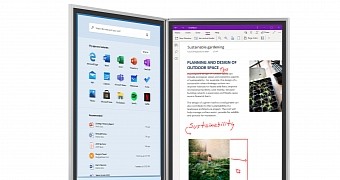Windows 10X is one of Microsoft’s most ambitious software projects lately, as it’s a new operating system supposed to power dual-screen and foldable experiences.
Announced in the fall of 2019, Windows 10X was also the platform that was originally planned to power the Surface Neo, Microsoft’s very own dual-screen device that was scheduled to launch in the holiday season of this year.
A lot has changed since Microsoft first shared these plans, and not only that the debut of Windows 10X was pushed back, but the Surface Neo itself also got delayed with no new ETA actually shared.
According to a new report, Windows 10X is now projected to hit the RTM development phase as soon as December, while the public launch should take place in the spring of the next year. This is a release calendar that has also made the headlines before and which would eventually push Windows 10 to a single feature update per year, as the spring release would become exclusive to Windows 10X.
For the time being, it’s not known if Microsoft wants to release Windows 10X to testers before the public launch, though there’s a good chance the company ends up doing this, especially because it needs everything to run as smoothly as possible.
At the same time, it’s important to emphasize that the focus of Windows 10X has also changed since Microsoft first announced this operating system. Windows 10X will first land on single-screen devices and only then go live for dual-screen PCs. According to people familiar with the matter, the single-screen experience will launch next year, possibly in the spring, while the dual-screen adventure would start in 2022, most likely when the Surface Neo is ready as well.
Microsoft itself confirmed earlier this year that Windows 10X will focus on the single-screen market at first.
“With that increased focus comes a shift in priorities for Windows too. The world is a very different place than it was last October when we shared our vision for a new category of dual-screen Windows devices. As we continue to put customers’ needs at the forefront, we need to focus on meeting customers where they are now. Our customers are leveraging the power of the cloud more than ever, and we believe the time is right to lean into this acceleration in a different way,” Microsoft said.
“With Windows 10X, we designed for flexibility, and that flexibility has enabled us to pivot our focus toward single-screen Windows 10X devices that leverage the power of the cloud to help our customers work, learn and play in new ways. These single-screen devices will be the first expression of Windows 10X that we deliver to our customers, and we will continue to look for the right moment, in conjunction with our OEM partners, to bring dual-screen devices to market.”
For now, however, the good news is that Windows 10X is still alive and is on its way to users, with the RTM build likely just around the corner.
In the meantime, users keep dreaming that more Windows 10X features would make the switch to the full Windows 10 desktop, including the Start menu, and it’s all because this operating system embraces a more modern design from one end to another.
Indeed, Microsoft is using Windows 10X as the source of inspiration for some features, but other than that, you’d better not hold your breath for the entire Start menu design to land on the desktop. Especially now that Microsoft brought theme-aware live tiles to the Windows 10 Start menu.

 14 DAY TRIAL //
14 DAY TRIAL //